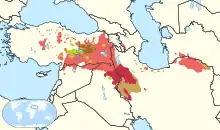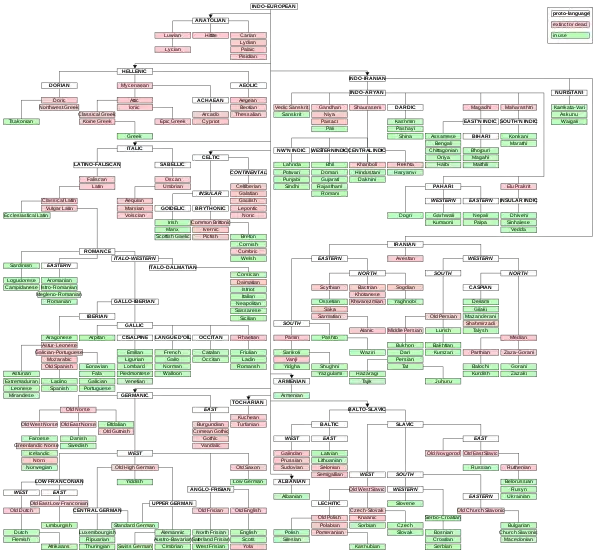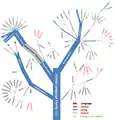Zaza language
Zaza or Zazaki[7] (Zazaki: Zazakî / Kirmanckî / Kirdkî / Dimilkî),[8] is an Indo-European language spoken primarily in eastern Turkey by the Zazas. The language is a part of the Zaza–Gorani language group of the northwestern group of the Iranian branch. The glossonym Zaza originated as a pejorative[9] and many Zazas call their language Dimlî.[10]
| Zaza | |||
|---|---|---|---|
| Zazakî / Kirmanckî / Kirdkî / Dimilkî | |||
| Native to | Turkey | ||
| Region | Provinces of Sivas, Tunceli, Bingöl, Erzurum, Erzincan, Elazığ, Muş, Malatya,[1] Adıyaman and Diyarbakır[2] | ||
Native speakers | 3–4 million (2009)[3] | ||
| Latin script | |||
| Language codes | |||
| ISO 639-2 | zza | ||
| ISO 639-3 | zza – inclusive codeIndividual codes: kiu – Kirmanjki (Northern Zaza)diq – Dimli (Southern Zaza) | ||
| Glottolog | zaza1246 | ||
| ELP | Dimli | ||
| Linguasphere | 58-AAA-ba | ||
 Geographic distribution of the Kurdish languages and Zaza–Gorani languages
| |||
 Zaza is classified as Vulnerable by the UNESCO Atlas of the World's Languages in Danger | |||
While Zaza is linguistically more closely related to Gorani, Gilaki, Talysh, Tati, Mazandarani and the Semnani language,[11] Kurdish has had a profound impact on the language due to centuries of interaction, which have blurred the boundaries between the two languages.[12] This and the fact that Zaza speakers are identified as ethnic Kurds by some scholars,[13][14] has encouraged linguists to classify the language as a Kurdish dialect.[15][16][17]
According to Ethnologue, Zaza is spoken by around three to four million people.[18] Nevins, however, puts the number of Zaza speakers between two and three million.[19]
History
Writing in Zaza is a recent phenomenon. The first literary work in Zaza is Mewlîdu'n-Nebîyyî'l-Qureyşîyyî by Ehmedê Xasi in 1899, followed by the work Mawlûd by Osman Efendîyo Babij in 1903. As the Kurdish language was banned in Turkey during a large part of the Republican period, no text was published in Zaza until 1963. That year saw the publication of two short texts by the Kurdish newspaper Roja Newe, but the newspaper was banned and no further publication in Zaza took place until 1976, when periodicals published a few Zaza texts. Modern Zaza literature appeared for the first time in the journal Tîrêj in 1979 but the journal had to close as a result of the 1980 coup d'état. Throughout the 1980s and 1990s, most Zaza literature was published in Germany, France and especially Sweden until the ban on the Kurdish language was lifted in Turkey in 1991. This meant that newspapers and journals began publishing in Zaza again. The next book to be published in Zaza (after Mawlûd in 1903) was in 1977, and two more books were published in 1981 and 1986. From 1987 to 1990, five books were published in Zaza. The publication of books in Zaza increased after the ban on the Kurdish language was lifted and a total of 43 books were published from 1991 to 2000. As of 2018, at least 332 books have been published in Zaza.[20]
Due to the above-mentioned obstacles, the standardization of Zaza could not have taken place and authors chose to write in their local or regional Zaza variety. In 1996, however, a group of Zaza-speaking authors gathered in Stockholm and established a common alphabet and orthographic rules which they published. Some authors nonetheless do not abide by these rules as they do not apply the orthographic rules in their oeuvres.[21]
In 2009, Zaza was classified as a vulnerable language by UNESCO.[22]
The institution of Higher Education of Turkey approved the opening of the Zaza Language and Literature Department in Munzur University in 2011 and began accepting students in 2012 for the department. In the following year, Bingöl University established the same department.[23] TRT Kurdî also broadcast in the language.[24] Some TV channels which broadcast in Zaza were closed after the 2016 coup d'état attempt.[25]
Dialects
There are two main Zaza dialects:
- Northern Zaza:[26] It is spoken in Tunceli, Erzincan, Erzurum, Sivas, Gumushane, Mus, Kayseri provinces.
Its subdialects are:
- West-Dersim[27]
- East-Dersim, Varto, Sarız, Koçgiri
- Southern Zaza:[28] It is spoken in primarily Bingöl, Çermik, Dicle, Eğil, Gerger, Palu and Hani, Turkey.
Its subdialects are:
- Sivereki, Kori, Hazzu, Motki, Dumbuli, Eastern/Central Zazaki, Dersimki.
Zaza shows many similarities with Kurmanji Kurdish:
- Similar personal pronouns and use of these[29]
- Enclitic use of the letter "u"[29]
- Very similar ergative structure[30]
- Masculine and feminine ezafe system[31]
- Both languages have nominative and oblique cases that differs by masculine -î and feminine -ê
- Both languages have forgotten possessive enclitics, while it exists in such other languages as Persian, Sorani, Gorani, Hewrami or Shabaki
- Both languages distinguish between aspirated and unaspirated voiceless stops
- Similar vowel phonemes
Ludwig Paul divides Zaza into three main dialects. In addition, there are transitions and edge accents that have a special position and cannot be fully included in any dialect group.[32]
Grammar
As with a number of other Indo-Iranian languages like the Kurdish languages, Zaza features split ergativity in its morphology, demonstrating ergative marking in past and perfective contexts, and nominative-accusative alignment otherwise. Syntactically it is nominative-accusative.[33]
Grammatical gender
Among all Western Iranian languages only Zaza and Kurmanji distinguish between masculine and feminine grammatical gender. Each noun belongs to one of those two genders. In order to correctly decline any noun and any modifier or other type of word affecting that noun, one must identify whether the noun is feminine or masculine. Most nouns have inherent gender. However, some nominal roots have variable gender, i.e. they may function as either masculine or feminine nouns.[34]
Phonology
Vowels
| Front | Central | Back | |
|---|---|---|---|
| Close | i | ɨ | u |
| ʊ | |||
| Mid | e | ə | o |
| Open | ɑ |
A vowel /e/ may also be realized as /ɛ/ when occurring before a consonant. /ɨ/ may become lowered to an /ɪ/ when occurring before a velarized nasal /n/; [ŋ], or occurring between a palatal approximant /j/ and a palato-alveolar fricative /ʃ/. Vowels /ɑ/, /ɨ/, or /ə/ become nasalized when occurring before /n/, as [ɑ̃], [ɨ̃], or [ə̃].
Consonants
| Labial | Dental/ Alveolar |
Palato- alveolar |
Palatal | Velar | Uvular | Pharyngeal | Glottal | |||
|---|---|---|---|---|---|---|---|---|---|---|
| plain | phar. | |||||||||
| Nasal | m | n | (ŋ) | |||||||
| Plosive/ Affricate |
voiceless | p | t | tˁ | t͡ʃ | k | q | |||
| voiced | b | d | d͡ʒ | ɡ | ||||||
| Fricative | voiceless | f | s | sˤ | ʃ | x | ħ | h | ||
| voiced | v | z | ʒ | ɣ | ʕ | |||||
| Rhotic | tap/flap | ɾ | ||||||||
| trill | r | |||||||||
| Lateral | central | l | ||||||||
| velarized | ɫ | |||||||||
| Approximant | w | j | ||||||||
/n/ becomes a velar /ŋ/ when following a velar consonant.[35][36]
Alphabet
The Zaza alphabet is an extension of the Latin alphabet used for writing the Zaza language, consisting of 32 letters, six of which (ç, ğ, î, û, ş, and ê) have been modified from their Latin originals for the phonetic requirements of the language.[37]
| Upper case | A | B | C | Ç | D | E | Ê | F | G | Ğ | H | I[upper-alpha 1] | Î[upper-alpha 1] | J | K | L | M | N | O | P | Q | R | S | Ş | T | U | Û | V | W | X | Y | Z |
|---|---|---|---|---|---|---|---|---|---|---|---|---|---|---|---|---|---|---|---|---|---|---|---|---|---|---|---|---|---|---|---|---|
| Lower case | a | b | c | ç | d | e | ê | f | g | ğ | h | i [upper-alpha 1] | î [upper-alpha 1] | j | k | l | m | n | o | p | q | r | s | ş | t | u | û | v | w | x | y | z |
| IPA phonemes | a | b | d͡ʒ | t͡ʃ | d | ɛ | e | f | g | ɣ | h | ɪ | i | ʒ | k | l | m | n | o | p | q | r, ɾ | s | ʃ | t | y | u | v | w | x | j | z |
- Zaza Wikipedia uses ⟨I/ı⟩ and ⟨İ/i⟩ instead of both I's in the table.
Gallery
 Partial tree of Indo-European languages.[38]
Partial tree of Indo-European languages.[38] Gippert, Jost (1999), Iranische Sprachen / Iranian Languages
Gippert, Jost (1999), Iranische Sprachen / Iranian Languages Position of Zaza language in Iranian Languages
Position of Zaza language in Iranian Languages
References
- "Zazaki, Northern". Ethnologue. Archived from the original on 4 June 2019. Retrieved 22 May 2019.
- "Zazaki, Southern". Ethnologue. Archived from the original on 4 June 2019. Retrieved 22 May 2019.
- Zaza at Ethnologue (25th ed., 2022)
Kirmanjki (Northern Zaza) at Ethnologue (25th ed., 2022)
Dimli (Southern Zaza) at Ethnologue (25th ed., 2022) - "Zazaki, Southern". Ethnologue. Retrieved 2022-05-21.
- Linguistik List Language Search - Zaza-Gorani
- "Glottolog 4.5 - Zaza". glottolog.org. Retrieved 2022-05-21.
- Kenstowicz, Michael J. (2004). Studies in Zazaki Grammar. MITWPL.
- Lezgîn, Roşan (26 August 2009). "Kirmanckî, Kirdkî, Dimilkî, Zazakî". Zazaki.net (in Zazaki). Archived from the original on 26 January 2021. Retrieved 23 December 2020.
- Arakelova, Victoria (1999). "The Zaza People as a New Ethno-Political Factor in the Region". Iran & the Caucasus. 3/4: 397–408. doi:10.1163/157338499X00335. JSTOR 4030804.
- Asatrian, Garnik (1995). "DIMLĪ". Encyclopedia Iranica. VI. Archived from the original on 2011-04-29. Retrieved 2021-06-11.
- Ehsan Yar-Shater (1990). Iranica Varia: Papers in Honor of Professor Ehsan Yarshater. Leiden: E. J. Brill. p. 267. ISBN 90-6831-226-X.
- Garry, Jane; Rubino, Carl R. Galvez (2001). Facts About the World's Languages: An Encyclopedia of the World's Major Languages, Past and Present. New York: H. W. Wilson. p. 398. ISBN 0-8242-0970-2.
- van Wilgenburg, Wladimir (January 28, 2009). "Is Ankara Promoting Zaza Nationalism to Divide the Kurds?". The Jamestown Foundation. Archived from the original on 2021-12-04. Retrieved 2015-11-27.
- Kaya, Mehmed S. (2011). The Zaza Kurds of Turkey: A Middle Eastern Minority in a Globalised Society. London: Tauris Academic Studies. p. 5. ISBN 978-1-84511-875-4.
- According to the linguist Jacques Leclerc of Canadian "Laval University of Quebec, Zazaki is a part of Kurdish languages, Zaza are Kurds, he also included Goura/Gorani as Kurds "Turquie : situation générale". tlfq.ulaval.ca (in French). Archived from the original on 2012-09-28. Retrieved 2012-10-28.
- T.C. Millî Eğitim Bakanlığı, Talim Ve Terbiye Kurulu Başkanlığı (2012). Ortaokul Ve İmam Hatip Ortaokulu Yaşayan Diller Ve Lehçeler Dersi (Kürtçe; 5. Sınıf) Öğretim Programı (PDF) (in Turkish). Ankara. Archived from the original (PDF) on 2012-10-21., "Bu program ortaokul 5, 6, 7, ve 8. sınıflar seçmeli Kürtçe dersinin ve Kürtçe’nin iki lehçesi Kurmancca ve Zazaca için müşterek olarak hazırlanmıştır. Program metninde geçen “Kürtçe” kelimesi Kurmancca ve Zazaca lehçelerine birlikte işaret etmektedir."
- Prof. Dr. Kadrî Yildirim & Yrd. Doç. Dr. Abdurrahman Adak & Yrd. Doç. Dr. Hayrullah Acar & Zülküf Ergün & Îbrahîm Bîngol & Ramazan Pertev, Kurdî 5 – Zazakî, Milli Eğitim Bakanlığı, 2012 Archived 2014-04-23 at the Wayback Machine
- "Turkey - languages". Retrieved 8 July 2022.
- Anand, Pranav; Nevins, Andrew (2004). "Shifty Operators in Changing Contexts". In Young, Robert B. (ed.). Proceedings of the 14th Semantics and Linguistic Theory Conference held May 14–16, 2004, at Northwestern University. Semantics and Linguistic Theory. Vol. 14. Ithaca, NY: Cornell University. p. 36. doi:10.3765/salt.v14i0.2913.
- Malmîsanij (2021), pp. 675–676.
- Malmîsanij (2021), pp. 676–677.
- Malmîsanij (2021), p. 681.
- Erdoğmuş, Hatip; Orki̇n, Şeyhmus (2018). "Bingöl ve Munzur Üniversitesinde Açılan Zaza Dili ve Edebiyatı Bölümleri ve Bu Bölümlerin Üniversitelerine Katkıları". Kent Akademisi (in Turkish). 11 (1): 164.
- Tabak, Husrev (2017). The Kosovar Turks and Post-Kemalist Turkey: Foreign Policy, Socialisation and Resistance. London: Bloomsbury Publishing. p. 35. ISBN 978-1-78453-737-1.
- Malmîsanij (2021), p. 679.
- kiu
- Prothero, W. G. (1920). Armenia and Kurdistan. London: H. M. Stationery Office. p. 19. Archived from the original on 2014-05-02. Retrieved 2013-09-15.
- diq
- Johanson, Lars; Bulut, Christiane (2006). Turkic-Iranian Contact Areas: Historical and Linguistic Aspects. Otto Harrassowitz Verlag. p. 293. ISBN 3-447-05276-7.
- Ludwig Windfuhr, Gernot (2009). The Iranian Languages. London: Routledge. p. 32. ISBN 978-0-7007-1131-4.
- Kahnemuyipour, Arsalan (7 October 2016). "The Ezafe Construction: Persian and Beyond" (PDF). Archived from the original (PDF) on 23 November 2018. Retrieved 23 May 2019 – via iub.edu.
- Paul, Ludwig (1998). Zazaki – Versuch einer Dialektologie (in German). Wiesbaden: Reichert Verlag.
- Haig, Geoffrey L. J. (2004). Alignment in Kurdish: A Diachronic Perspective (PDF) (Habilitation thesis). Christian-Albrechts-Universität zu Kiel. Archived from the original (PDF) on 29 January 2013. Retrieved 13 November 2012.
- Todd, Terry Lynn (2008). A Grammar of Dimili (also Known as Zaza) (PDF). Electronic Publication. p. 33. Archived from the original (PDF) on January 28, 2012.
- Ludwig, Paul (2009). Zazaki. The Iranian Languages: London & New York: Routledge. pp. 545–586.
- Todd, Terry Lynn (2008). A Grammar of Dimili (also Known as Zaza). Stockholm: Iremet.
- Çeko Kocadag (2010). Ferheng Kirmanckî (zazakî – Kurmancî) – Kurmancî – Kirmanckî (zazakî). Berlin: Weşanên Komkar. ISBN 978-3-927213-40-1.
- "worldhistory". worldhistory.com by Multiple authors. Retrieved 2021-12-19.
Literature
- Arslan, İlyas. 2016. Verbfunktionalität und Ergativität in der Zaza-Sprache. Dissertation, Universität Düsseldorf.
- Blau, Gurani et Zaza in R. Schmitt, ed., Compendium Linguarum Iranicarum, Wiesbaden, 1989, ISBN 3-88226-413-6, pp. 336–40 (About Daylamite origin of Zaza-Guranis)
- Gajewski, Jon. (2004) "Zazaki Notes" Massachusetts Institute of Technology.
- Gippert, Jost. (1996) "Historical Development of Zazaki" University of Frankfurt
- Haig, Geoffrey. and Öpengin, Ergin. "Introduction to Special Issue Kurdish: A critical research overview" University of Bamberg, Germany
- Larson, Richard. and Yamakido, Hiroko. (2006) "Zazaki as Double Case-Marking" Stony Brook University and University of Arizona.
- Lynn Todd, Terry. (1985) "A Grammar of Dimili" University of Michigan
- Mesut Keskin, Zur dialektalen Gliederung des Zazaki. Magisterarbeit, Frankfurt 2008. (PDF)
- Malmîsanij, Mehemed (2021). "The Kirmanjki (Zazaki) Dialect of Kurdish Language and the Issues it Faces". In Bozarslan, Hamit; Gunes, Cengiz; Yadirgi, Veli (eds.). The Cambridge History of the Kurds. Cambridge: Cambridge University Press. doi:10.1017/9781108623711.027. ISBN 978-1-108-62371-1. S2CID 235541104.
- Paul, Ludwig. (1998) "The Position of Zazaki Among West Iranian languages" University of Hamburg
- Werner, Brigitte . (2007) "Features of Bilingualism in the Zaza Community" Marburg, Germany
External links
- Zaza People and Zazaki Literature
- News, Articles and Columns (in Zaza)
- News, Folktales, Grammar Course (in Zaza)
- News, Articles and Bingöl city (in Zaza)
- Center of Zazaki (in Zaza, German, Turkish, and English)
- Zazaki Language Institute (in Zaza, German, and Turkish)
- Website of Zazaki Institute Frankfurt
- "Zaza a Northwestern Iranic language of eastern Turkey". Endangered Language Alliance.